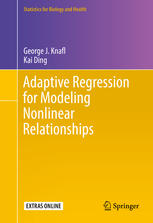

Most ebook files are in PDF format, so you can easily read them using various software such as Foxit Reader or directly on the Google Chrome browser.
Some ebook files are released by publishers in other formats such as .awz, .mobi, .epub, .fb2, etc. You may need to install specific software to read these formats on mobile/PC, such as Calibre.
Please read the tutorial at this link: https://ebookbell.com/faq
We offer FREE conversion to the popular formats you request; however, this may take some time. Therefore, right after payment, please email us, and we will try to provide the service as quickly as possible.
For some exceptional file formats or broken links (if any), please refrain from opening any disputes. Instead, email us first, and we will try to assist within a maximum of 6 hours.
EbookBell Team

5.0
88 reviewsThis book presents methods for investigating whether relationships are linear or nonlinear and for adaptively fitting appropriate models when they are nonlinear. Data analysts will learn how to incorporate nonlinearity in one or more predictor variables into regression models for different types of outcome variables. Such nonlinear dependence is often not considered in applied research, yet nonlinear relationships are common and so need to be addressed. A standard linear analysis can produce misleading conclusions, while a nonlinear analysis can provide novel insights into data, not otherwise possible.
A variety of examples of the benefits of modeling nonlinear relationships are presented throughout the book. Methods are covered using what are called fractional polynomials based on real-valued power transformations of primary predictor variables combined with model selection based on likelihood cross-validation. The book covers how to formulate and conduct such adaptive fractional polynomial modeling in the standard, logistic, and Poisson regression contexts with continuous, discrete, and counts outcomes, respectively, either univariate or multivariate. The book also provides a comparison of adaptive modeling to generalized additive modeling (GAM) and multiple adaptive regression splines (MARS) for univariate outcomes.
The authors have created customized SAS macros for use in conducting adaptive regression modeling. These macros and code for conducting the analyses discussed in the book are available through the first author's website and online via the book’s Springer website. Detailed descriptions of how to use these macros and interpret their output appear throughout the book. These methods can be implemented using other programs.